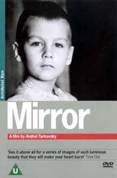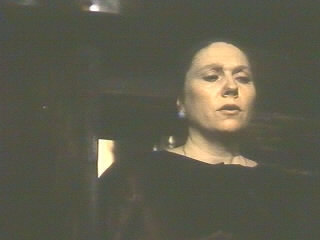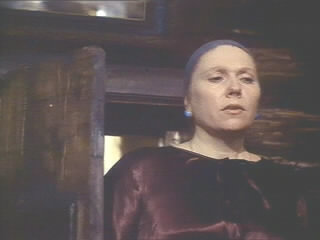
Nostalghia.com presents...Reflections around the new Mirror
An eagerly awaited installment in the Russian Cinema Council's Tarkovsky DVD series was released on July 29 in the United Kingdom. The Mirror is distributed in the U.K. by the Artificial Eye Film Company Ltd. Note that this is a Region 2 PAL disc which means a multi-region, multi-system player is required to view it, if you happen to live in an orthodox Region 1 NTSC country like the U.S. or Canada. For this mini-review — which in the end turned out rather more technical than usual — we used two such players (Malata PDVD-N996 and Apex AD-600A) to minimise the risk of blaming on the disc what could possibly be mere PAL-to-NTSC conversion artifacts. [Postscriptum: While the disc is indeed labeled R2, it is in actual fact an R0 disc]. The picture quality is excellent. Whether one compares it to the grainy, edge over-enhanced DVD from Kino Video, or the slightly fuzzy Japanese Toho laserdisc, or even to the 35mm prints from the Soviet era, this video is a winner simply by virtue of its smooth, clean, luminous texture. It is especially filmlike in appearance when viewed in the progressive scan mode: the smoothness and the detail are astounding. Another big bonus is a very interesting interview with Aleksandr Misharin (co-writer of the screenplay).Unfortunately, here the list of superlatives must end. For reasons unknown, RusCiCo has again decided to publish not Tarkovsky's original work but a significantly altered version. They have thus repeated their earlier mistake of similarly corrupting Stalker on DVD (see e.g., our News page entry for 29 January, 2002). That version of Stalker subsequently had to be replaced due to the public outcry that ensued. There are two types of alterations in the new Mirror:
We now focus our attention on each of these two problem areas, in turn.
AudioThe following are just some examples of the many changes that have been made to the soundtrack.
The original (director approved) mono soundtrack is not included as a Menu option on the DVD. In the following side-by-side comparison, we note the rather noisy soundtrack of the Kino DVD (which is, of course, one of the reasons why the RusCiCo release was so eagerly awaited in the first place). It is, in spite of its noisiness, a musically acceptable soundtrack. The RusCiCo/Artificial Eye audio track, however, presents us with what is perhaps one of the more idiosyncratic renditions of Bach ever to find its way into the digital domain.
VideoThe above mentioned excessively bright transfer of certain scenes appears most clearly contradicted by one of the characters in the film herself: the doctor's wife to whom Alyosha's mother wants to sell the turquoise earrings. She enters the room in which the light had gone out and she says to Alyosha: "And why are you sitting in the dark?" This scene is transferred so bright that it looks as if she was standing in broad daylight. Compare:
Another example is that beautiful shot of the hand illuminated by a flame. When the exposure is right, it looks like the hand is on fire. This illusion simply does not work on the new DVD, since we can see both the background and the burning firewood behind the hand very clearly. The opening credits are for some reason redone slightly: they do not always fade-out/fade-in. Sometimes the following fade-in comes earlier, resulting in a dissolve. And sometimes not. It appears almost random, and results in a rather "homemade" look of the credits.
ReflectionsWe find all of this rather puzzling. Why would a company like RusCiCo, a company presiding over such an ambitious project as the release of hundreds of Russian film classics on the DVD within the next few years, be so careless when it comes to publishing some of the most carefully crafted works ever put on film? (One is also tempted to wonder why a traditionally quality conscious and discriminating publisher like Artificial Eye would choose to distribute a defective product.) It is well-known from Tarkovsky's interviews, from his books, from his friends, even from anecdotes, how meticulous he was about everything and how important every little sound or detail was to him. He would study how exactly the mud from the bottom of the pond raised before he decided where to film the short scene with the Narrator as a boy, swimming. He would listen for a difference between the sound of milk and water splashing on the floor. This is the sort of thing any would-be restorer of a Tarkovsky film should keep in mind.Why is it that Arts other than Film have long-established traditions and specific procedures for publication of the old Masters, while people involved in publication of films behave as if none of this knowledge existed. Why do they insist on reinventing the wheel while Literature has its science of textual analysis from the holograph manuscript down to first editions; while researchers in the field of Classical Music know of a systematic approach toward producing an Urtext; while highly trained experts deduce which stroke of the paintbrush belongs to whom on a painting under restoration. Yet for some reason all this seems completely alien to the practice of film restoration, and the custodians of the original elements have no reservations about making them available to pretty much anybody: people whose only credentials are directions from their managers to do the work. Undoubtedly everybody involved means well but restoration of world class art is not just a hobby, it's a serious profession.
We certainly do not mean to begin a crusade against RusCiCo here. We appreciate the
tremendous amount of energy and good work that must have gone into getting
the Council off the ground. But what would the world say if the Louvre started repainting
the Mona Lisa to make it more snappy, or some publisher came up with a rewritten
and "more readable" edition of Proust's A la recherche...? FOOTNOTE: For RusCiCo's point of view click here. Note that a corrected version of this DVD was released in early 2003. For more details see the news items dated January 4 and 7, 2003. ©2002 - Jan Bielawski/ Trond Trondsen of Nostalghia.com. |




